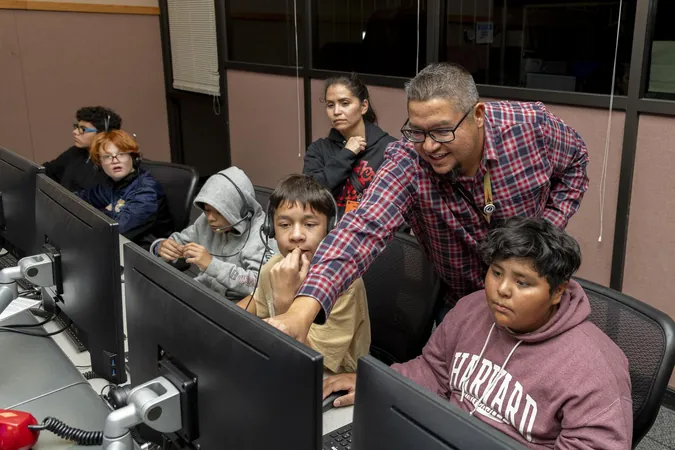
Unveiling Homo juluensis: The Mysterious Big-Headed Ancestor of Humanity
2024-12-02
Author: Liam
Groundbreaking Discovery of Homo juluensis
In a groundbreaking discovery, researchers have unveiled a new species of ancient humans named Homo juluensis, translating to "big head." This fascinating revelation stems from an extensive study of fossil evidence found in China, a significant contributor to our understanding of hominin evolution during the Middle Pleistocene epoch, approximately 300,000 to 50,000 years ago.
Migration of Human Ancestors
After Homo sapiens emerged roughly 300,000 years ago, human ancestors began to migrate from Africa into other regions, including Europe and Asia. Yet, understanding the variety of human ancestors that existed before modern humans, especially during the span from about 700,000 to 300,000 years, has presented a persistent challenge for paleoanthropologists. Fossils from ancient species such as Homo heidelbergensis in western Europe and Homo longi in central China have sparked ongoing debates within the scientific community about their classification and evolutionary relationships.
Research and Findings
A team of researchers, including anthropologist Christopher Bae from the University of Hawai'i at Mānoa and paleoanthropologist Xiujie Wu from the Chinese Academy of Sciences, published a pivotal article in the journal *The Innovation* in 2023. They argued that the continued reliance on broad categorizations like "archaic Homo" and "Middle Pleistocene Homo" hinders a deeper understanding of these ancient hominin relationships.
Delving deeper, their latest study published in *PaleoAnthropology* in May 2024 examined an intriguing collection of ancient hominin fossils discovered at Xujiayao, northern China, decades earlier. The fossils were characterized by an unusually large skull with features reminiscent of Neanderthals, while also possessing traits typical of modern humans and Denisovans.
Evidence of Hominin Complexity in East Asia
Their findings indicate these fossils represent a newly identified hominin group, which they have named Juluren or "large head people," contributing to a growing realization of the complexity of human evolution in east Asia during this period. The fossils—dating between 220,000 and 100,000 years ago—were unearthed alongside over 10,000 stone artifacts discovered in Xujiayao since the mid-1970s, representing about 10 different individuals. Each skull showed evidence of substantial brain capacity and robust construction, indicating a significant level of sophistication in these ancient humans.
Interbreeding and Genetic Connections
Interestingly, while Homo juluensis is being recognized as a new species, researchers believe that they were likely not genetically isolated. The analysis suggests that this group could be a product of interbreeding among various Middle Pleistocene hominins, including Neanderthals, supporting the notion that hybridization played a crucial role in shaping human evolutionary trajectories in eastern Asia.
Ongoing Classification and Future Research
Despite its recent introduction into the scientific lexicon, the designation Homo juluensis is gaining traction among experts. Paleoanthropologist John Hawks emphasized the importance of such names in evolutionary biology for enabling effective communication about different concepts and populations. This development has sparked renewed interest, but the classification of H. juluensis remains under discussion. Notably, paleoanthropologist Chris Stringer raised questions about its classification, suggesting that the characteristics of H. juluensis may align more closely with H. longi, highlighting the ongoing complexities in pinpointing the exact relationships among these ancient humans.
Conclusion: The Adventure of Our Origins Continues
As paleontologists continue to unearth more fossils and enhance the understanding of human evolution, the potential of Homo juluensis adds a powerful piece to the intricate puzzle of our ancestry, leaving us eager for what future discoveries may hold. What other secrets lie hidden in the past, waiting to be uncovered? The adventure of our origins is far from over!









 Brasil (PT)
Brasil (PT)
 Canada (EN)
Canada (EN)
 Chile (ES)
Chile (ES)
 España (ES)
España (ES)
 France (FR)
France (FR)
 Hong Kong (EN)
Hong Kong (EN)
 Italia (IT)
Italia (IT)
 日本 (JA)
日本 (JA)
 Magyarország (HU)
Magyarország (HU)
 Norge (NO)
Norge (NO)
 Polska (PL)
Polska (PL)
 Schweiz (DE)
Schweiz (DE)
 Singapore (EN)
Singapore (EN)
 Sverige (SV)
Sverige (SV)
 Suomi (FI)
Suomi (FI)
 Türkiye (TR)
Türkiye (TR)